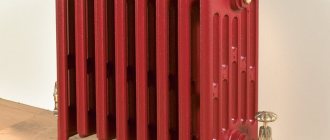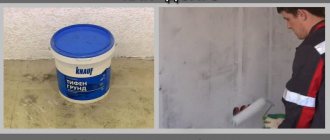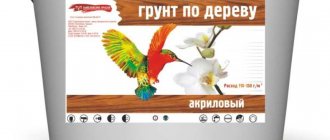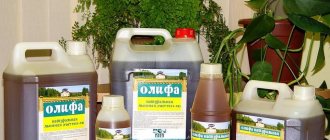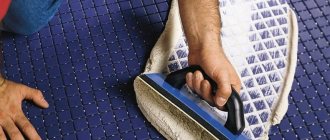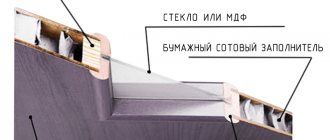To obtain reliable adhesion of finishing materials to the surface during repairs, various processing preparations are used. A good choice would be to use a concrete-contact primer.
It is important to select the components of the material so that the incoming components do not separate from the base. Concrete contact contains polymer adhesive, which ensures its strong adhesion to the base. The result is a rough coating that can hold any decorative finish.
Purpose and varieties
When preparing surfaces for further finishing, concrete contact is used due to its adhesive properties. Penetrating into the base material, it forms a rough layer that can easily be covered with finishing materials. Another of its advantages is to absorb moisture that forms on concrete structures.
Unlike a regular primer, using concrete contact allows you to save yourself from such work as cleaning walls and ceilings from old paint or whitewash. It can be applied directly to the paint; in any case, the base adheres. It is a primer and also serves as a waterproofing layer. It can be applied under tiles in bathrooms, kitchens and baths.
Certain types of this product are used for exterior finishing work; it is frost-resistant. For street work, soil containing expanded clay or marble chips, as well as coarse quartz sand, is used. This composition will hold heavy facade plaster well on concrete walls. If it is covered on the outside with concrete contact, it will be reliably protected from atmospheric influences.
Concrete contact can be used in various ways, depending on the incoming components and the size of the quartz sand particles. Concrete contact, which includes coarse sand, is more often used for processing porous bases.
How to prepare surfaces for processing?
Before application, the surface must be thoroughly cleaned of dust and dirt; if it is a floor, it must be vacuumed. If there are places on the surface that are peeling or crumbling, then it is better to remove them immediately and plaster over the uneven areas with cement mortar. Priming is carried out after the plaster has completely dried. Concrete contact does not stick to greasy surfaces, and if there are such areas, they need to be washed thoroughly, and only after degreasing do they begin processing.
Before priming, areas with paint are washed with a damp sponge and after drying, Concrete Contact is applied. We recommend pre-treating surfaces that cannot be thoroughly cleaned with an ordinary primer. This procedure will reduce material consumption due to the fact that ordinary soil will fill large cracks and roughness. After treatment, minor blockages are removed, and the Concrete Contact will adhere more strongly to the surface.
Composition and characteristics
Concrete contact primer has the following composition of components:
- Portland cement or cement;
- Quartz sand;
- Acrylic polymer;
- Technological additives that ensure its vapor permeability, hygroscopicity, protection from chemical and biological influences.
The composition of the concrete contact necessarily includes quartz sand with different grain sizes. For example, Ceresit soil contains a fine-grained mineral filler; it is used for treating smooth substrates.
The acrylic contained in the base of the concrete contact is a polymer adhesive that provides adhesion to the base. In addition, dyes are added to the concrete contact. They help determine the thickness of the covering layer and visually detect unpainted areas.
Concrete contact has the following technical characteristics:
- Environmentally friendly product. Does not emit an unpleasant odor or harmful fumes. Its use does not require additional body and respiratory protection;
- Resistant to aggressive environments;
- Forms a waterproofing layer;
- Allows air to pass through, which eliminates the formation of mold and mildew;
- Drying time at 20°C and 70% humidity is 3 hours;
- Manufacturers have established a service life of 80 years;
- Recommended temperature for indoor work is from +5 to +30°C and humidity 55-80%.
How long the concrete contact will dry depends on the temperature and humidity in the room. Under unsuitable conditions, additional heating can be used to speed up the process.
Consumption
The consumption of concrete contact primarily depends on the size of the sand particles and the condition of the treated surface. If it is too porous and rough, it will require more material than if it is smooth.
Let us give the consumption of concrete contact per 1 m2 for various surfaces:
- For painted walls, metal and glass bases, ceramic tiles, and other smooth and low-porous coatings, 150 g/m2 is required;
- Medium-porous structures made of concrete slabs and finishing bricks will require 300-350 g/m2;
- For very rough substrates such as concrete, building bricks, the consumption rate increases to 500 g or more per square meter.
To reduce costs, for highly porous substrates, conventional deep penetration primers are used, which are much cheaper.
Instructions for use
Before you begin, you should prepare the foundation. The processing process includes the following steps:
- Wash the surface from dust or dirt;
- Remove aggressive formations: grease, bitumen, glue and others;
- Beat off poorly fitting plaster, remove peeling paint, remove loose wallpaper.
Concrete contact primer requires application to a dust-free surface; this is the main condition for obtaining a solid, prepared base for finishing. Structures washed with water must dry thoroughly before application.
If the walls were previously covered with chalk, they are washed with soapy water and dried. Lime whitewash is removed if it crumbles and peels off.
The composition of the concrete contact primer is selected depending on the quality and condition of the surfaces being treated.
Usually, the concrete-contact primer is ready for use; you just need to mix the composition before work. Sometimes it is diluted with water as directed by the manufacturer. It is important to ensure that the mixture does not contain lumps.
Concrete contact is applied using painting tools - brushes, rollers, or you can use a spray gun. Uneven walls made of concrete or brick are covered with a wide brush. This ensures penetration of the concrete contact into cracks and seams.
For smooth surfaces it is better to use a roller. You should try to apply stripes without leaving spaces between them. If the first layer has gaps, you need to apply the next one to paint it well. The next layer is applied after the previous one has dried.
The primed coating dries after 3-12 hours. This time is indicated on the package, but you need to take into account the room temperature and humidity. To make sure that the soil is dry, you can lightly scratch it with a knife or spatula. Do not continue work if the layer strength has not been achieved.
Online calculator for calculations
Online calculators are available on specialized websites, and their use is completely free. Qualified builders took part in the development, so the likelihood of error is reduced to zero. By going to the desired website and opening the online calculator, you just need to enter the necessary parameters:
- type of primer mixture;
- type of surface material;
- planned number of applied layers.
Many consumers do not believe that priming with concrete contact is necessary, and in order to save money they refuse this procedure. But if quality and the elimination of further problems are a priority, then applying a primer is necessary. The savings are insignificant, and it is sometimes very difficult to eliminate unpleasant consequences.
Manufacturers
A number of companies producing concrete-contact primers are known on the construction market. They produce mixtures of various prices and compositions, which are divided by purpose and area of application.
Knauf
The concrete contact primer from this manufacturer is characterized by a finely dispersed composition based on fine quartz sand. Used to cover smooth surfaces before finishing with plaster, lime, gypsum, tile adhesive, and other finishing and decorative materials. Forms a rough surface.
Betonokontakt Prospectors
Contains latex, which increases the strength of the base after processing. It is used to cover surfaces that do not absorb moisture well. This is monolithic concrete, dilapidated cracked tiles, and other surfaces made of dense materials.
This type dries quickly (2 hours). When working with it, the productivity of construction work increases significantly. Characterized by economical consumption - 200 g/m2. Before use, just shake the contents of the jar.
Ceresit
It has a water-dispersed component in the base, contains polymers and coloring pigments. Covers smooth concrete surfaces tightly before plastering. We get a vapor- and moisture-proof coating.
This primer should not be diluted with water; it is not advisable to use a roller when processing. Can only be used for interior work. Is non-toxic.
Axton
This is a dry mixture for priming. High-quality primer for construction and finishing works. Before use, just add the required amount of water and mix. The resulting mixture is ready for use.
Axton concrete contact is used for untreated, rough substrates. The mixture consumption is 300 g/m2, dries within 3 hours.
So, we have determined what concrete contact is used for. The use of a universal and reliable primer greatly simplifies construction. This material provides high performance properties of structures and allows for a variety of finishing of external and internal surfaces.
What general properties does concrete contact have?
In a nutshell, the function of concrete contact is to create conditions for gluing foreign materials without the use of complex adhesives. The very composition of this type of soil allows it to “stick” to any surface. Unique adhesive ability is achieved by combining many elements.
Primer Lakra betonokontakt for external work
Concrete contact primer has quite a wide range of applications:
- It perfectly bonds finishing and building materials with smooth, glossy surface textures.
- Improving the quality of adhesion of plastered walls.
- Finishing surfaces without preliminary cleaning of previously applied materials. As an example: a high-rise building with a tiled facade is easier to treat with concrete contact than to clean everything down to bare walls.
Visualized technical characteristics of concrete contact primer
The concrete contact primer has characteristics of a higher class - they turn it into an indispensable independent material for finishing work:
- Long service life. Some manufacturers provide a guarantee of up to 80 years for the preservation of the properties of their products. Who will check the truth of such “speeches of the Reds”, because, most likely, during the specified time, restoration work will be carried out in the premises more than once.
- Drying speed. A correctly applied concrete contact layer needs no more than two to three hours for it to dry and work with it can continue.
- Moisture resistance. When it dries, a film forms on the surface of the concrete contact. It is absolutely waterproof and serves as waterproofing, thereby protecting the main surface of the wall from adverse influences.
- Low consumption. There are certain standards according to which a specific amount of substance is required per unit area. But, due to a number of circumstances, they cannot always be observed. Therefore, everything here is individual. Much depends on the surface being treated. Porous or rough texture will require a thicker layer of primer.
Traditionally, concrete contact primers are divided by type of surface and can be treated with a specific composition: for metal, wooden walls, and so on. However, in practice this is not always taken into account, since the classification is conditional.
Concrete contact primer, the composition of which is not always the same, must be purchased for specific work from a specific brand.
